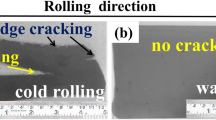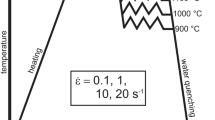Abstract
The main goal of this work was to evaluate the effectiveness of Walker’s equation in collapsing the fatigue crack propagation data of a SAE AMS 7475-T7351 aluminum alloy loaded either longitudinally (L-T) or transversely (T-L) to the rolling direction. T-L orientation testpieces presented lower ductility and fracture toughness values than L-T orientation. As a consequence, during the fatigue crack propagation tests, T-L testpieces exhibited a stronger influence of monotonic modes of fracture, resulting in higher Paris exponent values,m. Walker’s model was able to collapse fatigue crack propagation data of L-T test pieces at different applied stress ratios,R. However, for the T-L orientation, due to theR ratio dependency onm andC, simply averaging ofm values for the calculations of Walker’s exponent proved to be inefficient. A simple analytical procedure was proposed by the authors to modify Walker’s model to take into account such effect. For T-L test pieces, when Walker’s model is modified by considering both Paris’s exponent as well the coefficient as a function of theR ratio, the fatigue crack growth data collapses within a narrow band, thus allowing predictions to be made satisfactorily. The collapsed band is even narrower if the empirical relationm=a+blogC is used instead of simple polynomial equations due to a better correlation coefficient.
Similar content being viewed by others
References
R.G. Forman, V.E. Keary, and R.M. Engle, Numerical Analysis of Crack Propagation in Cyclic-Loaded Structures,J. Basic Eng., 1967,89, p 459–464
J. Weertman, Rate of Growth of Fatigue Cracks Calculated from the Theory of Infinitesimal Dislocations Distributed on a Plane,Int. J. Fract. Mech., 1966, 2460–2467
M. Klesnil and P. Lukas, Influence of Strength and Stress History on Growth and Stabilization of Fatigues Cracks,Eng. Fract. Mech., 1972,4, p 77–92
R.J. Donahue, H.M. Clark, P. Atanmo, R. Kumble, and A.J. McEvily, Crack Opening Displacement and the Rate of Fatigue Crack Growth,Int. J. Fract. Mech., 1972,8, p 209–219
A.J. McEvily, On Closure in Fatigue Crack Growth,Mechanics of Fatigue Crack Closure, ASTM STP 982, 1988, p 35–43
A.K. Vasudevan, K. Sadananda, and N. Louat, A Review of Crack Closure, Fatigue Crack Threshold and Related Phenomena,Mater. Sci. Eng. A, 1994,188A, p 1–22
A.J. McEvily and R.O. Ritchie, Crack Closure and Fatigue Crack Propagation Threshold as a Function of Load Ratio,Fat. Fract. Eng. Mater. Struct., 1998,21, p 847–855
D. Kujawski, A New (ΔK+Kmax)0.5 Driving Force Parameter for Crack Growth in Aluminum Alloys,Int. J. Fat., 2001,23, p 733–740
D. Kujawski, Enhanced Model of Partial Crack Closure for Correlation of R-ratio Effects in Aluminum Alloys,Int. J. Fat., 2001,23, p 95–102
W.T. Riddel and R.S. Piascik, Stress Ratio Effects on Crack Opening Loads and Crack Growth Rates in Al Alloy 2024,NASA, 1998,TM-206929, p 1–17
K. Walker, The Effect of Stress Ratio During Crack Propagation and Fatigue for 2024-T3 and 7075-T6 Aluminum,Effects of Environment and Complex Load History on Fatigue Life, ASTM STP462, 1970, p 1–14
A.R. Rosenfeld, Fracture Mechanics in Failure Analysis,Metals Handbook: Fatigue and Fracture, 10th ed., vol. 19, ASM International, 1997, p 450–456
J. Zheng and B.E. Powell, Effect of Stress Ratio and Test Methods on Fatigue Crack Growth Rate for Nickel Based Superalloy Udimet720,Int. J. Fat., 1999,21(5), p 507–513
SAE AMS 2355, Quality Assurance Sampling and Testing of Aluminum Alloys and Magnesium Alloys,Wrought Products, Except Forging Stock, and Rolled, Forged, Or Flash Welded Rings, Aer. Mat. Spec., SAE Int., 2002
“Standard Test Method for Measurement of Fracture Toughness. American Society for Testing and Materials,” E1820-01,Annual Book of ASTM Standards, vol.03.01, ASTM, 2001
“Standard Test Methods for Tension Testing of Metallic Materials [Metric]. American Society for Testing and Materials,” E8M-00,Annual Book of ASTM Standards, vol.03.01, ASTM, 2000
“Standard Test Method for Measurement of Fatigue Crack Growth Rates. American Society for Testing and Materials,” E647-00,Annual Book of ASTM Standards, vol.03.01, ASTM, 2000
C. Cui, R. Wu, Y. Li, and Y. Shen, Fracture Toughness of In Situ TiCp-AlNp/AL Composite,J. Mater. Proc. Tech., 2000,100, p 36–41
W.H. Hunt, T. Osman, and J.J. Lewandowski, Micro and Macrostructural Factors in DRA Fracture Resistance,J. Mater., 1993,45(1), p 30–35
I.C. Stone and P. Tsakiropoulos, The Effect of Reinforcement on the Notched and Unnotched Room Temperature Tensile Properties of AL-4wt.%Cu:SiC MMCs,Mater. Sci. Eng. A, 1998,A241, p 19–29
C.P. You, A.W. Thompson, and I.M. Bernstein, Aging Effects on Fatigue Crack Growth and Closure in a SiC Reinforced 2124 Aluminum Composite,J. Metall., 1988,40(7), p A88
E.H. Niccolls, A Correlation for Fatigue Crack Growth Rate.Scripta Metall. Scripta Metall., 1976,10, p 295–298
Author information
Authors and Affiliations
Corresponding author
Rights and permissions
About this article
Cite this article
Di Todaro, E., Ruckert, C.T.O.F., Milan, M.T. et al. Modeling of stress ratio effect on Al alloy SAE AMS 7475-T7351: Influence of loading direction. J. of Materi Eng and Perform 15, 608–613 (2006). https://doi.org/10.1361/105994906X136160
Received:
Revised:
Issue Date:
DOI: https://doi.org/10.1361/105994906X136160




